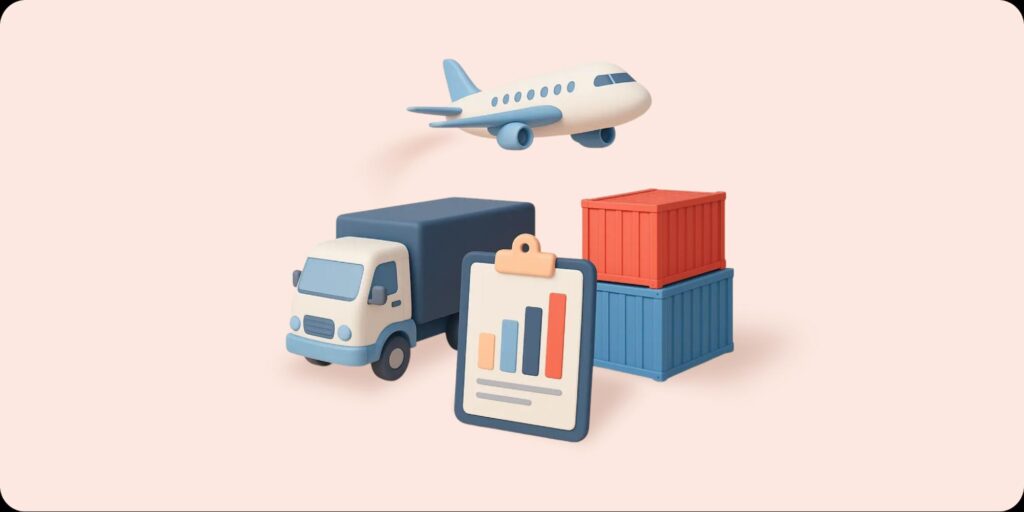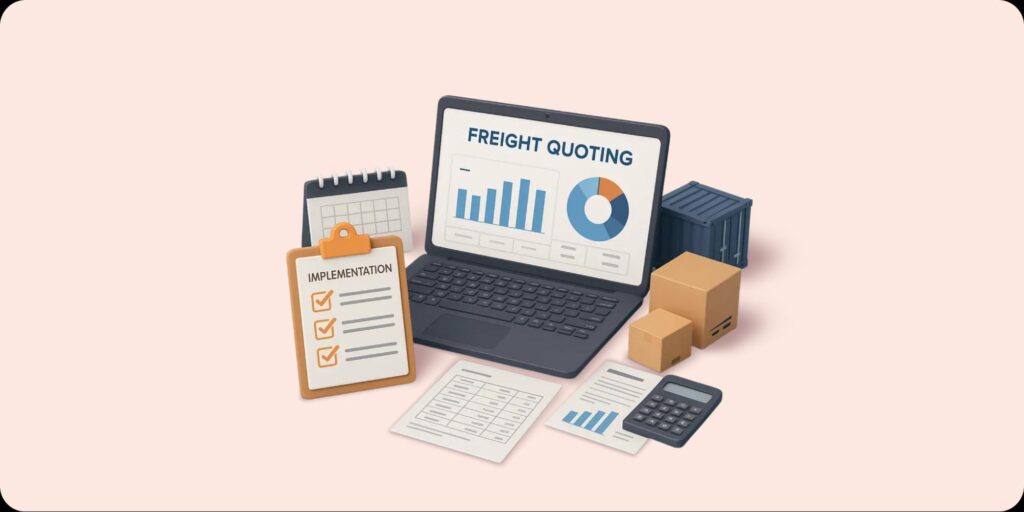Key Takeaways
- Air freight is 12–15x costlier than sea freight but delivers in 1–7 days, offering high security and minimal handling for urgent or high-value cargo.
- Sea freight is slower at 14–40+ days but ideal for bulk, cost-sensitive, or heavy shipments, with lower emissions and fewer cargo restrictions.
- Air freight suits urgent deliveries, fragile/high-value items, and small shipments, while sea freight fits planned, high-volume moves and goods needing flexible handling.
- Mode choice depends on urgency, geography, budget, handling needs, and customs complexity: air for speed, sea for cost efficiency.
- Wisor’s AI-driven platform automates air vs. sea mode selection using real-time rates, cost indexes, and shipment data, cutting decision time and improving accuracy.
Air Freight vs Sea Freight: 8 Key Differences
Choosing between air and sea freight is a routine but critical decision for freight professionals. Each shipment requires balancing speed, budget, carbon footprint, risk, and flexibility, alongside evolving considerations around freight rate management.
Typically, ocean freight – also referred to as sea freight – is the standard for planned, cost-sensitive shipments, especially when timelines are flexible. In contrast, air freight offers faster delivery, lower handling risk, and added security, which is ideal for high-value or urgent cargo.
Understanding the trade-offs between the two modes helps teams make smarter, case-by-case decisions. To help you decide between them, here’s a side-by-side comparison of how air and sea freight differ across key logistics criteria:
| Consideration | Air Freight | Sea Freight |
| Cost Structure | Air freight costs are high. Typically 12-15x the cost of ocean freight, indexed and updated weekly. Based on volume and weight. | Cost-effective, costs based on TEU or FEU volume index, typically stable for much of the year. |
| Speed | 1-7 days for most freight. | 15-40+ days for most freight. |
| Cargo Volume | Freight capacity for cargo planes is in pounds, ranging from 10,000 to 250,000 per flight. | Cargo ships carry about 5,000-20,000 TEUs of ocean freight, which range from 2,000-50,000 lbs each. |
| Environmental Impact | High carbon emissions per kg shipped. | Low carbon emissions per kg shipped. |
| Risk | Risk is low because cargo is handled for a minimum amount of time. Most cargo planes are heavily insured against disaster. | Risk depends on season, Incoterms in question, and the ocean shipping lane. |
| Customs Clearance & Documentation | Freight must be strictly documented upfront and typically cleared in advance to meet flight schedules. | Freight must be thoroughly documented and may have to go through multiple stages of customs, depending on the shipping lane. |
| Route & Schedule Flexibility | Very flexible, as cargo planes fly frequently. | Very little flexibility, as cargo ships depart on schedule for a pre-chartered route. |
| Insurance & Security Protocols | Carrier insurance typically covers catastrophic events, but forwarders often purchase additional insurance for high-value cargo. | Carriers offer little insurance, and forwarders should insure their own goods if Incoterms place responsibility on the buyer. |
How Air Freight Works
Air freight is a relatively fast process that typically takes 1-7 days, depending on route and wait times.
- Shipper/forwarder books the shipment and prepares documentation, including the air waybill with shipper and buyer information, destination, and description of goods.
- Goods are weighed, measured, and packed onto ULD containers or pallets. Goods are labelled based on airline restrictions.
- Goods clear export customs, and any duties or taxes must be paid.
- Cargo is loaded onto the cargo plane. It may transfer to multiple planes depending on the route.
- Cargo is unloaded at the destination airport and clears import customs, where duties and taxes must be paid again.
- The freight forwarder or carrier typically handles final-mile delivery to the consignee.
When to Choose Air Freight
Air freight makes up anywhere from 3.9-40% of total freight, depending on location and destination. While expensive, air freight has a lot to offer. It’s ideal for:
- Urgent, time-sensitive deliveries.
- Introducing mode flexibility to ensure deliveries meet SLAs even when shipping lanes aren’t performing.
- Small/valuable shipments where air freight is still less than 20% of the cost of the cargo.
- LCL shipments that might actually cost more to ship via sea, where you pay by TEU or FEU.
- Fragile cargo that requires extra handling (Ships don’t have the capacity to offer special handling).
- Cargo that requires extra security (Ships often don’t have the resources to offer special security).
Air Freight Restrictions
Air freight restrictions vary based on the classification of hazardous materials. Many types of dangerous goods – such as explosives, flammable liquids and solids, gases, oxidizers, toxic or infectious substances, radioactive materials, corrosives, lithium batteries, strong magnetic items, and temperature-sensitive perishables like medications – can still be transported by air, but only under strict IATA packaging, labeling, and documentation protocols. Freight forwarders typically obtain the most current guidelines directly from IATA or specific air carriers.
How Sea Freight Works
Ocean freight can take months to prepare and be delivered to a harbor. Typically, it starts with choosing a scheduled ship and chartering space.
- Forwarder selects a ship and books cargo space in Twenty Foot Equivalent or Forty Foot Equivalent units.
- Cargo is prepped, palletized, and loaded into marine containers.
- Shipping documents are prepared with a bill of lading.
- Where applicable, goods clear export customs, and any taxes or duties are paid.
- Goods are unloaded at the destination port. It’s rare for goods to change ships, but this may happen if the route is very long.
- Goods are inspected, and any import customs or duties are paid.
- Goods move into a loading warehouse to be picked up by the carrier or the buyer directly.
When to Choose Ocean Freight
Ocean freight offers a reliable, cost-effective shipping solution for bulk cargo. Depending on region and lane, it makes up anywhere from just over 95% to about 60% of all cargo. It’s ideal for situations like:
- Planned shipments where there’s time to align a ship schedule with delivery deadlines.
- Cost-sensitive shipments where low costs are critical. Typically, the rule of thumb is that cargo ocean freight costs should not exceed 20% of the value of the cargo.
- Shipping high volume or high weight goods that would be too costly to ship via air.
- When flexibility is needed in terms of cargo types or dangerous goods.
Sea Freight Restrictions
Sea freight restrictions vary per carrier and per lane. For example, shipping flammable and explosive materials requires acquiring permits and finding a carrier willing to handle those goods. However, in most cases, ocean freight means you can ship restricted goods, provided you have the proper documentation, notification, and certification.
Did You Know?
While air freight generally costs 12–15 times more than sea freight, it can reduce handling time by more than 70%, substantially decreasing the likelihood of damage and related insurance claims.
Pros and Cons of Air Freight vs Sea Freight
Air and ocean freight are both strong options for moving cargo. However, each applies in different circumstances. Understanding those pros and cons can help you match cargo to transport mode. While many of the differences between air and sea freight have already been discussed, here’s a quick pros-and-cons overview to summarize the key decision-making factors at a glance:
| Criteria | Air Freight | Sea Freight |
| Speed | 1–7 days (fastest mode) | 14–40+ days (lane-dependent) |
| Cost | High cost per kg (suitable for lightweight, urgent goods) | Cost-effective for large and heavy shipments |
| Security | High control, minimal touchpoints | More handling, moderate security risk |
| Volume Capacity | Limited by weight and aircraft size | Ideal for high-volume, high-weight cargo |
| Flexibility | Frequent departures, adaptable in transit | Fixed schedules, fewer route options |
| Environmental Impact | Higher emissions per shipment | Lowest emissions per kg shipped |
Air Freight Pros
Air freight has a lot of advantages for freight forwarders and freight shippers.
- With average delivery times of 1-7 days, there’s no faster option than air freight. With expedited freight, even bulk freight arrives in under 3 days.
- High-value and perishable goods are exposed to less risk because handling time is lower and security is higher.
- Goods are moved quickly in and out of loading, meaning less warehousing and therefore fewer delays.
- Planes fly frequently and can be rechartered quickly, creating high route and timing flexibility.
Air Freight Cons
Air freight isn’t always the right choice. In many cases, it’s costly and offers less flexibility in terms of allowed cargo than ocean freight.
- According to the World Bank, air freight is typically $1.50-$4.50 per kg, or about 4-5x the cost of road transport and about 12-15x the cost of sea transport.
- Cargo planes support a fraction of the capacity of a cargo ship, meaning that cargo weight and volume are greatly restricted.
- Air cargo passes through more and stricter safety and customs checks.
- Emissions per kg of cargo are much higher, raising the carbon footprint.
Sea Freight Pros
Sea freight offers slow but cost-effective transport for freight forwarders and shippers able to plan ahead.
- Cargo ships are the most cost-effective transport mode, typically 12-15 times cheaper than air.
- Load weight and volume limits practically don’t exist.
- Costs are calculated per TEU or FEU, which reduces rates for heavy and oversized cargo.
- Emissions per kg shipped are much lower than air freight, for a better carbon footprint.
Sea Freight Cons
Ocean freight isn’t right for every circumstance. For example, last-minute freight with a high need for timely delivery should not be shipped by sea.
- Delivery times average 14-40 days depending on distance and lane.
- Delays are out of your control, with factors like port congestion, weather, lane congestion, etc., all coming into play.
- Scheduling is fixed and often influenced by seasonal demand cycles and weather-related factors.
- The risk of damage, delayed arrival, or even misrouting is higher with less insurance coverage.
Air Freight vs Sea Freight: Which One to Choose?
Ocean and air freight are each valid options, and each has a best-fit scenario. Depending on shipment, you’ll want to consider factors like deadline, geography, budget, and customs.
1. Shipment Urgency and Frequency
High-urgency shipments should always go by air. On the other hand, frequent and predictable shipments can be scheduled far in advance, making sea a great choice. The higher your scheduling capabilities, the better you can apply ocean freight for regularly recurring shipments.
2. Origin-Destination Geography
Most air freight occurs inland between Asia and the Middle East. Some air freight also occurs domestically in the U.S. Overall, look at port location, connections to overland hubs, and the cost of switching carrier or mode at destination. If a sea cargo shipment must be transported by rail or truck and then hauled overland, it might be cheaper to opt for air freight, especially if delivery SLAs are tight.
3. Budget, Storage, and Handling Capabilities
Sea cargo is packed into a container and roughly handled in the same way, no matter what is in the container. If cargo needs special handling, it cannot go in a sea container. That’s also true if cargo should be unloaded and on its way ASAP after docking. Sea cargo becomes accessible to carriers only after container unloading, which can take several days depending on port congestion.
4. Customs and Compliance Complexity
Air cargo is often ideal for streamlined cargo that can quickly pass customs and security checks. Goods with complex customs requirements that might see long delays during customs inspections or require complex paperwork are often better suited for sea cargo. You’ll also want to consider the environmental impact based on SLAs. If you need a low carbon footprint, the sea is the way to go.
Make Smarter Shipping Decisions with Wisor’s AI-Driven Freight Platform
Wisor streamlines freight mode selection between air and sea freight, with smart algorithms and AI analysis to ensure rates, risks, and real-world conditions are taken into account.
- Dynamic Mode Selection Based on Cost and Timeline: Wisor analyzes cost, delivery SLAs, and shipment volume to recommend the optimal mode for each shipment.
- Real-Time Rate Shopping for Multimodal Shipments: Wisor integrates rate cards and cost indexes from modes and carriers, allowing for real-time rate shopping with comparison against benchmarks for easy visibility into costs and savings opportunities.
- Visibility, Automation, and AI-Powered Freight Decisioning: Wisor integrates with carriers to offer real-time visibility into shipment location and delivery timeline, with seamless document automation at every step, so stakeholders always know the next steps.
- Seamless Integration with TMS and Logistics Systems: Seamlessly integrates with transport management systems and logistics systems to enable multimodal transport, handoff between carriers, and align shipments with strict delivery timelines for air and sea freight.
Conclusion
Choosing a freight transportation mode means looking at shipment size, weight, and needs. Often, the idea is to balance costs against delivery timelines and risk. Therefore, freight requiring speedy delivery or high-value freight is a best fit for air. This can also apply to less-than-container-load (LCL) shipments, which may cost more to ship by sea than by air. Ocean freight is ideal for regular and schedulable, high volume, and high weight cargo.
Eventually, choosing the right mode depends on real-world circumstances, current air rate indexes, and individual carrier rates. Tracking that real-time data enables smarter decision-making with costs and delivery timelines in mind.
Wisor automates freight mode selection using indexed and real-time carrier rates, so you always choose the best option, fast. Request a demo to see how it works.








